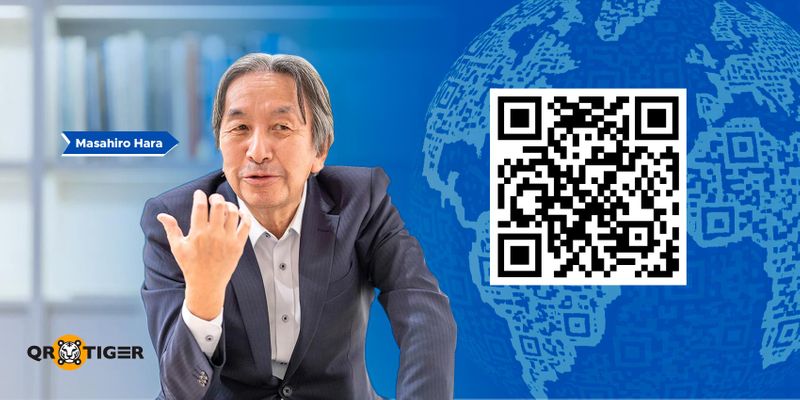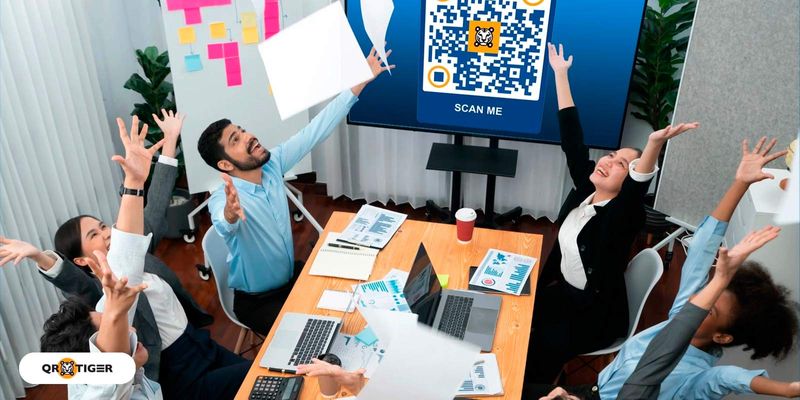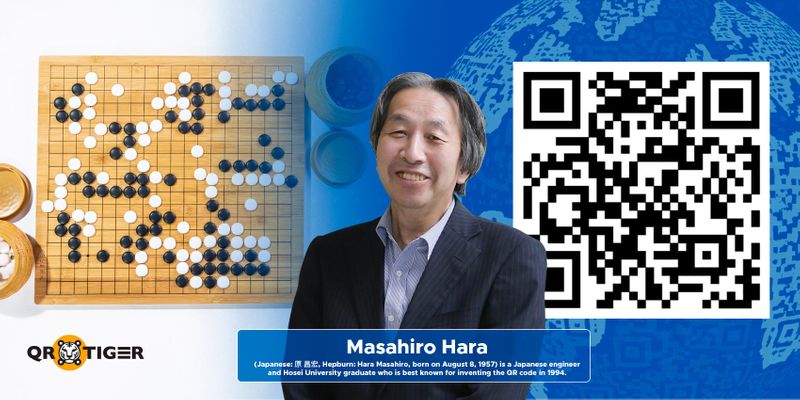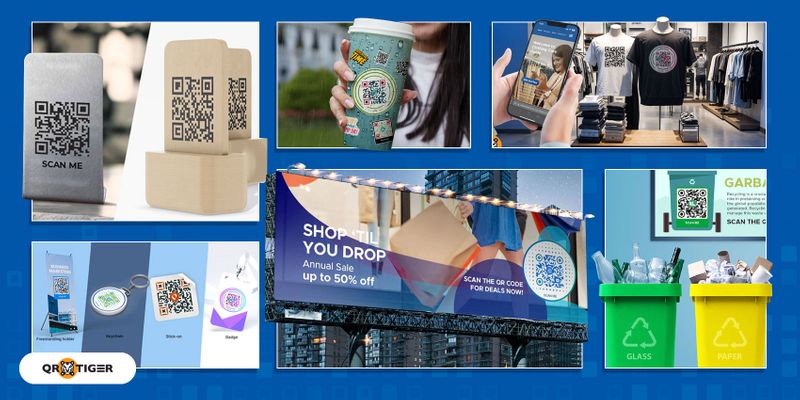August 21 is World QR Code Day: A Tribute to Masahiro Hara

We just can’t deny that QR codes are now part of our daily lives. From scanning menus at restaurants to accessing boarding passes at airports, QR technology is leaving a mark on the world with each scan.
How QR codes convert vast amounts of information into a compact, scannable format has opened up limitless possibilities for businesses and consumers.
Thanks to the development of an advanced QR code generator, creating these codes is easier than ever, making them accessible to everyone.
But the QR code's story is more than just about convenience; it’s a tale of human innovation and problem-solving.
Developed in Japan in the early 1990s, the QR code was first used to track vehicles in manufacturing.
Today, QR codes bridge the gap between the physical and digital realms, simplifying processes and enhancing user experiences.
Table of Contents
- What is World QR Code Day, and why does it matter?
- When is World QR Code Day?
- A month of innovation deserves an innovative icon
- Honoring the mind behind the code
- QR code through the years: the historical milestones
- How can businesses and individuals join the World QR Code celebration?
- Inspiring transformation: QR codes across industries
- What the numbers are really telling us
- From tiny beginnings to global impact
- Frequently asked questions
What is World QR Code Day, and why does it matter?
It is a global celebration to honor the invention of the QR code and its inventor and recall its journey throughout the years. It is celebrated to spotlight QR codes’ history, impact, uses, benefits, and versatility.
Masahiro Hara invented QR codes in 1994 to make tracking automotive parts much easier. What began as a factory tool has evolved into a universal symbol of instant access to a wide array of information.
Why we celebrate QR code day:
- to honor the innovation
- give tribute to Masahiro Hara
- celebrate global digital transformation
- recognize its power and simplicity
- encourage tech literacy and creativity

When is World QR Code Day?
August is the official World QR Code Month, and World QR Code Day is celebrated annually on August 21.
Every August 21, we celebrate QR Code Day to honor the groundbreaking QR code invention. This day highlights the creativity and innovation behind QR codes, which are transforming industries like retail, marketing, healthcare, and education.
💻 You may also watch this video to learn more:
A month of innovation deserves an innovative icon
August once stood as a month devoted to celebrating the minds behind groundbreaking inventions.
National Inventors Month was first recognized in August 1998 by the United Inventors Association of the USA (UIA-USA), the Academy of Applied Science, and Inventors Digest to honor creativity, ingenuity, and the courage to experiment.
However, in 2011, the celebration was moved to May to fit the academic calendar better and align with the National Inventors Hall of Fame ceremony.
While May now shines as the month of invention, August remains historically tied to innovation. It’s a time that still resonates with the spirit of discovery and the excitement of groundbreaking ideas.
To fill this gap and honor August's innovative legacy, the world now celebrates World QR Code Day on August 21st.
The Quick Response (QR) code, a testament to human ingenuity, perfectly embodies innovation. This square-shaped, two-dimensional barcode is transforming our day-to-day interactions.
QR codes symbolize progress, making the phygital world a reality. By dedicating a day to this technology, we can celebrate this remarkable invention and honor the spirit of innovation that has long defined August.
Honoring the mind behind the code

Masahiro Hara, a name often overlooked in the tech world, is the genius behind the QR code.
In 1994, while working as an engineer at Denso Wave, a Japanese company, Hara was tasked with finding a more efficient way to track vehicles on assembly lines as the world was poised for a digital transformation.
His clever solution was a two-dimensional barcode capable of storing far more information than traditional barcodes.
Before he came up with this smart tool, he had his eureka moment while playing the Go board game during lunchtime.
In an interview with Masahiro Hara in 2020, he walked us through his thought process on how he came up with such a brilliant idea:
“We had been making barcode readers for 10 years so we had the knowhow. I was looking at the board and thought the way the stones were lined up along the grids … could be a good way of conveying lots of information at the same time.”
And that’s how QR codes were born.
At the time, he had no idea this would be a groundbreaking invention.
He was amazed when the codes were used for payments. He’s even surprised when they became such a useful tool during the COVID-19 pandemic.
“I’m really pleased that it’s being been used to help improve people’s safety,”
“Back in 1994 we were focused on its use in the economy … we never thought it would be used for something like this.”
Initially designed for industrial use, the QR code has since evolved into a widely accessible tool. With the best QR code generator available online, it’s easy for anyone to create codes.
Hara's invention, once limited to factory floors, has become a democratized resource for businesses and individuals.
Though we often take this technology for granted, it's important to recognize its creator's brilliance and foresight. Masahiro Hara's legacy lives on in every QR code scan.
QR code through the years: the historical milestones
| Year/Period | Milestone | Description |
| 1994 | Invention | Masahiro Hara at Denso Wave invented the QR code to streamline automotive part tracking. It enables high data capacity and fast, omnidirectional scanning. |
| 1997-2000 | Formal standardization | QR codes are standardized: AIM (1997), JIS (1999), and ISO/IEC 18004 (2000). Denso Wave allows free use by not enforcing its patents. |
| 2002 | Japan: The early adopter | The SHARP J-SH09 was the first mobile phone in Japan with a built-in QR scanner. QR codes are used in ads, vending machines, transit, and more. |
| 2010s | Global popularity and adoption | Global usage begins but remains limited due to the need for third-party apps. Usage appears in logistics and marketing. |
| 2017 | Camera app integration | QR scanning becomes native in iOS 11 (2017) and later Android versions, removing friction and boosting adoption. |
| 2020s | Pandemic as a global catalyst | COVID-19 drives global QR use: contact tracing, menus, payments, check-ins. This touchless system aims to minimize physical contact. |
| 2022 | Surge in global QR code usage | Over 26.9 million global QR scans were recorded in 2022 alone. High usage across industries: marketing, retail, restaurants, and events. |
| 2023 and beyond | Creative innovations | Dynamic QR codes are becoming popular for real-time updates and analytics. Innovative uses include AI-generated QR art, video QR links, and branded campaigns. |
How can businesses and individuals join the World QR Code celebration?
Businesses
Here’s how companies can celebrate:
- Launch QR-powered campaigns
If your business runs a campaign in August, it is the best time to use QR codes. Use them for special offers, discounts, or fun gimmicks.
To give you ideas, here are some successful QR code campaigns worldwide that can inspire you.
- Tell us your QR code story
Inspire others by sharing your QR code journey. Share a post or video highlighting how you use QR codes and their impact on your business.
- Educate your audience
Share an informational post, video, or blog. Share the QR code history, basics, uses, or benefits. Simply show and tell them what they should know about QR codes.
- Create your branded QR code
Officially hop into the QR code bandwagon by creating your customized, branded QR code with your business logo.
Individuals
Here’s how individuals can celebrate:
- Dig the history
Read articles or watch videos that discuss the QR code history to deepen your understanding of what it’s used for, where it all started, when it began, why it was invented, or how it’s used.
- Create your own QR code
Generate your personalized QR code to learn how it works. Explore different QR code types, generate and customize them, scan, download, and share.
- Share a surprise QR code
Show the QR code magic to your friends and family. Create a unique QR code with a surprising message, video, music, or photos. It could be anything you want to share.
Inspiring transformation: QR codes across industries
QR codes have quietly transformed how we live, work, and interact with the world. You've likely encountered these square barcodes multiple times, from when you wake up to when you go to bed.
QR codes are woven into our daily routines, whether boarding a bus with a QR code ticket or accessing event information with a quick scan.
This is because their influence spans various industries. Here’s a glimpse into their usage and impact across various sectors:
| Industry | QR code usage | Impact | Brands using QR codes |
| Retail | QR codes link to a website, product details, review page, customer care, mobile app, or payment page. | Effortless information, interactive experiences, and faster checkout processes. | Walmart, Target, Tesco, Amazon, Nike, Sephora, 7-Eleven |
| Food & Beverage | QR codes as assistive technology for touchless ordering. Also used to lead to manufacturing processes, promotions, or campaigns. | Foster brand trust, drive conversion, and better customer engagement | McDonald's, Entrecôte Petit Louis, Pepsi, Coca-Cola, Mountain Dew, Nestlé, Poppi, Hershey's, Jupiler, Wendy's |
| Logistics & Supply Chain | QR codes facilitate package tracking, inventory management, authentication, customer support, and feedback. | Easy and accurate package tracking and monitoring, better transparency, enhanced delivery confidence, and reduced human error | Logmore, FedEx, UPS, DHL |
| Healthcare | QR code for contact tracing, patient check-in and check-out, digital records, medicine and drug authenticity check, and equipment manuals | Secure and accurate medical records, improved efficiency, smarter medical services, reduced human error, less medicine and drug counterfeits | CityMedic, Public Health England, Southwest Iowa Clinic, Myanmar's Ministry of Health, National Health Service (UK), Japan hospitals |
| Education | QR code for modules or digital materials, online resources, online classes, online quizzes and exams, attendance, video tutorials, enrollment, announcements, and library | Interactive learning experience, easy access to supplementary materials and resources, and personalized learning opportunities. | Harvard University, West Virginia University, Malaysian universities, San Diego State University, George Fox University Library |
| Marketing & Advertising | QR code for digital ads, print ads, banners, billboards, posters, TV ads, guerrilla, out of home, seasonal campaigns, and more | Personalized marketing, targeted and mobile-first campaigns, effortless A/B testing, accurate campaign tracking, and smarter marketing approach | Burger King, Puma, FashionTV, Coinbase, Blackbridge, Diageo, Associated Media Publishing, CyGames and Bilibili |
| Entertainment & Events | QR code for concerts or shows, product launch, trade shows, music and lights festival, seminars or webinars, conferences, showcases, and networking events | Boosts attendee engagement, better venue entry, streamlined attendance, accurate event attendee tracking, and smarter event operations | 1010 Wine and Events, Art Deco Trust, Zest Events International, Coachella, Lantern Festival in China, Loy Krathong |
| Hospitality & Tourism | QR codes to assist hotel operations, promote tourist spots, showcase tourism videos, facilitate travel, hotel check-ins and check-outs, direct to tour maps or guides, and more | Touchless hotel services, smarter tourism operations, smoother travel experience, streamlined check-ins and check-outs, instant access to accurate maps and tour guides | The Acres Club, Marriott Hotels, Singapore Tourism Board, Singapore Airlines, United Airlines, Doha Hamad International Airport |
What the numbers are really telling us
If there’s one thing the latest data makes clear, it’s this: QR codes are no longer optional. They’re essential.
QR codes aren’t just a trend. They’re reshaping how we interact, pay, market, and share information.
Across industries and countries, we’re seeing a massive shift in how people connect through digital touchpoints. And at the center of it all? The humble QR code. Smarter, sleeker, and more strategic than ever.
Here’s what the QR code statistics report is saying, with insights into what it means for businesses and consumers:
QR codes are taking over, and they're just getting started
A 22% global growth in QR code usage this year? That’s not just a spike. It’s a signal. U.S. adoption alone is pushing past 100 million users.
💡 What this means: QR codes have officially gone mainstream. It isn’t just a passing trend; it’s a long-term behavior shift.
They’re now a universal access point for digital experiences used by consumers and businesses alike, in nearly every industry.
If your brand still treats QR codes like a sidekick, you’re missing the main plot.
Here’s the bottom line: QR codes have become the default bridge between offline and online. You're already behind if your business still treats them like a novelty.
Mobile-first isn’t just a trend. It’s the playbook.
With 59% of smartphone users scanning QR codes daily and nearly 1 in 3 using them for payments, we’ve officially entered a mobile-first world. And QR codes are leading the charge.
💡 What this means: Mobile-first strategy is no longer optional. Brands must optimize everything, from campaigns to checkout experiences, with smartphones in mind. QR codes are the gateway to this mobile-first world.
Let that sink in. Your customers are now scanning, tapping, and transacting on the go, so your strategy needs to live in their hands.
Whether you're building a product, running a campaign, or rethinking customer experience, design with the mobile scanner in mind.
Scanning will be the “new norm”
9 in 10 users scan a QR code at least once a week, and more businesses are catching up. 93% of marketers ramped up their QR efforts in the past year.
💡 What this means: QR scanning is now a natural consumer behavior, like tapping a screen or swiping a card. Businesses need to anticipate this behavior and build it into product labels, menus, ads, and in-store displays.
QR scanning is now second nature. Consumers expect it. Your signage, packaging, events, and ads should make scanning intuitive, fast, and rewarding.
Let’s be real. Scanning a QR code isn’t something people “learn” anymore. It’s automatic. Almost 90% of users scan at least once a week, without even thinking twice.
Point is, you’re not asking them to do something new. You’re meeting them where they already are. The only question is: what are you giving them when they scan?
QR code-powered campaigns are driving real results
We're not talking vanity metrics. On average, QR-powered campaigns deliver a click-through rate of 37%. That’s leagues ahead of many digital ads. Plus, 95% of businesses say QR codes are helping them collect crucial first-party data.
💡 What this means: QR codes are a marketer’s best friend. They engage users, collect valuable data, and offer real-time tracking.
Think about the industry giants like Amazon, Nestlé, McDonald’s, Pepsi, Coca-Cola, and Walmart. These giants are crushing QR code-powered campaigns.
More local and international brands are also doing it. Why? Because QR codes give them the power to convert, connect, and gather real-time campaign data through a single scan. Plus, they fit into their audience’s mobile-first lifestyle.
More creative QR code uses are emerging

Those plain QR codes? They’re evolving. From plain black-and-white squares, we can now see customized QR codes, AI-designed QR art, logos embedded in the codes, and even QR tattoos that actually work.
Plus, big brands are using them for way more than links. They use QR codes for smart and interactive packaging, event check-ins, loyalty programs, promos, AR/VR, and games.
💡 What this means: QR codes are no longer just static, plain, boring squares. They’re smart and versatile. They’re being reimagined as interactive, branded, and even artistic tools that enhance user experience and build stronger brand identity.
Today, QR codes are becoming more than functional. They’re becoming an experience.
The best QR campaigns don’t just redirect; they delight. A well-placed, well-designed QR can elevate the customer journey in ways that are memorable and measurable.
Creativity wins. When you combine function and flair, people don’t just scan. They remember.
QR code is the future…in life and business
QR payments are expected to hit over $3 trillion this year. That’s not a small corner of the market. That’s a full-on shift.
Countries across Asia are building cross-border QR systems. It’s fast. It’s seamless. It’s changing how people transact, travel, and connect.
💡 What this means: QR codes are shaping the future of digital and physical interaction. QR codes are at the center of everything from how we pay, travel, and experience.
Here’s the big picture: Sustainability, convenience, and real-time data drive QR's rise. From packaging to point-of-sale to public transport, the tech is quietly but powerfully transforming how the world works.
If you think QR is just a marketing tool, think again. It’s infrastructure now.
Scan with caution
Here’s the catch: Behind every technological advancement and rising adoption come security risks.
Around 2% of scanned QR codes are malicious, and executives are 42 times more likely to face QR-based phishing attacks (aka quishing). It’s a real threat. So yes, go big on QR, but make sure your tech, your team, and your users are protected.
2% may sound small, but considering billions of scans occur daily, millions of devices are exposed to phishing.
Hackers now target high-value individuals with quishing (QR phishing). This makes security awareness vital.
💡 What this means: Security must also evolve to combat these security risks. Security awareness and QR code verification should be part of every company’s QR strategy.
If you’re scaling your QR code strategy, build in security from the start to stay ahead of evolving threats. Educate users. Vet QR destinations. Use safe and secure QR code generators that comply with the highest security and privacy standards.
From tiny beginnings to global impact
QR codes have undergone an extraordinary evolution, transforming from a simple tool for tracking cars on assembly lines to an indispensable part of our daily lives.
This small square barcode has made a lasting impact, from the busy metropolis to the quiet rural areas.
The introduction of advanced QR code generators has democratized this technology, allowing both individuals and businesses to create and use QR codes for a wide range of applications.
Whether it's sharing contact details or accessing digital menus, the possibilities are limitless. World QR Code Day is the perfect time to honor this remarkable invention.
It's a day to celebrate the creators' ingenuity, the technology's versatility, and the many ways it has enriched the world. We can only be excited about the new and innovative uses that will emerge.
Frequently asked questions
Who invented the QR code in the world?
The first-ever QR code was invented by Masahiro Hara, a Japanese engineer at Denso Wave. Since traditional barcodes can only store a limited amount of data, he created QR codes to store more information and easily track automotive parts.
When were QR codes invented?
QR codes were invented in Japan in 1994. At the time, the automotive industry needed a faster, more efficient way to track parts. Traditional barcodes just weren’t cutting it, so Masahiro Hara developed QR codes to store more data and scan from any angle.
When did QR codes become popular?
QR codes became popular in Japan around 2002 to 2003, especially when mobile phones began integrating built-in QR scanners. It was only in 2017, when they gained global traction, that iOS and Android finally supported QR code scanning through camera apps.
Why are QR codes so popular?
QR codes are smart, fast, flexible, and extremely easy to use, which is why they’re popular around the world. Plus, they’re cost-effective. In a mobile-first era, QR codes are now an essential tool.
When did QR codes start in America?
While QR codes were invented in Japan, they started popping up in the U.S. during the early 2010s. Best Buy was the first US retailer to use QR codes to give shoppers fast access to product information.
How to celebrate World QR Code Day?
On August 21, you can celebrate QR code day by recognizing its impact on tech, business, and daily life by creating your own and using them for various purposes.





